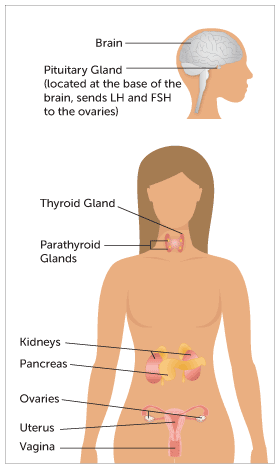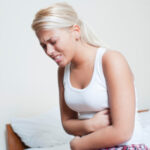Menstrual Period: General Information
Key Facts
- Periods usually start between 9-15 years of age.
- Periods are often irregular the first 1-2 years.
- It’s a good idea to keep track of your periods.
Puberty is the time when your body changes because of hormones produced by your ovaries. Puberty usually starts between age 8 and 13 and includes growth of your breasts, the appearance of hair in your genital and underarm areas, and a growth spurt in your height. You may also notice that you have body odor and some discharge in your vaginal area from the effect of the hormones. Usually your menstrual periods will start about 2 to 3 years after you notice the first signs of breast development. The age when you start puberty may be earlier or later than others your age because late or early puberty may run in your family. Puberty may start earlier in girls who are overweight and later in girls who are underweight or involved in sports or activities such as dance, gymnastics or track.

Puberty begins when the pituitary gland in your brain begins to release chemical messengers called gonadotropins, Follicle-Stimulating Hormone (FSH) and Luteinizing Hormone (LH), which in turn stimulate your ovaries inside your belly to make hormones, especially estrogen. The estrogen causes breast development and menstrual periods. The two small, grape-shaped ovaries are also filled with hundreds of thousands of eggs. Menstrual periods occur because the lining of the uterus (called the endometrium) thickens because of rising levels of estrogen and when the levels fall, the lining is not supported and passes out of your body through the vagina as a “period.” As your system matures, the gonadotropins send different levels of hormones that “tell” your ovaries to release an egg once a month and to make progesterone in addition to estrogen. The egg then travels towards the uterus. If the egg is not fertilized by a sperm, then two weeks later, the levels of estrogen and progesterone fall and the blood filled lining of the uterus that becomes thicker between periods passes out of your body through your vagina. This flow, which comes out as blood, is your menstrual period. The whole process is called menstruation. Menstrual periods can occur when you are releasing eggs each month or they can occur when you are just making estrogen. When you are not ovulating, the periods may be lighter or heavier than normal and more irregular.
What will having my period feel like?
Some girls may experience premenstrual syndrome “PMS.” Symptoms of PMS usually start about a week before your period and disappear about 1-2 days into your period. Signs and symptoms of PMS may include mood swings, acne, bloating, food cravings, increased breast tenderness, fatigue, and increased hunger and thirst. When your period begins, it’s normal to experience mild pain with your periods a couple of days each month. However, if your pain is not relieved with over-the-counter pain medicine, and you miss school or doing things with your friends because of it, you may have “dysmenorrhea” (pronounced: dis–men–o–ree–a). When your period begins, it will feel like liquid flowing slowly with start and stops, out of your vagina. Although it may seem like a lot of blood, only a small amount is released at a time and should not be painful. It’s also normal to see small clots of blood from your vagina on the toilet paper after you urinate (pee). However, if you see clots larger than a quarter, you should call your health care provider (HCP) and schedule an appointment.
What if I haven’t had my period yet?
It’s normal to get your period as early as 9 years old or as late as 15 years old. This is a big time range, and it’s hard to be one of the first or one of the last. Children who are active in sports or are very thin may not get their period until a later age. Losing weight while you are in your growth spurt can also delay your periods. A late start to puberty and menstrual periods may run in your family. Talk to your parent or your healthcare provider about your worries and concerns. If you haven’t gotten your period by the time you have turned 15 or if you haven’t had your period or breast development by age 13, get a check-up with your health care provider (HCP) just to make sure everything is okay. Your HCP sees many children who develop late, so don’t be embarrassed to ask. Your HCP may do a genital exam and check to see if your hymen (a thin piece of tissue that covers part of the entrance to your vagina) is open. Some children are born with an “imperforate hymen,” which means that the hymen does not have an opening, and blood cannot leave the vagina. Rarely, children are born with a condition called Mayer Rokitansky Kuster Hauser syndrome (MRKH), which is an incomplete vagina and/or small or absent uterus, so they don’t get their period for this reason. It’s a good idea to get regular check-ups during puberty just to make sure that everything is okay.
How often will I get my period?
You will likely get your period about once every month. A typical menstrual cycle is about 28 days. This means that there will be about 28 days from the first day of your period to the first day of your next period. 28 days is an average number, but anywhere between 21 and 35 days is normal. In the first year of having periods, most girls have at least 4 periods; the second year, at least 6 periods; and for the 3rd to 5th year, at least 8 periods each year. Most adults have 9 to 12 periods a year. Your period will usually last between 3 and 7 days. The amount of blood flow you have will probably be different each day. You will usually have the most blood in the beginning of your period and the least towards the end. When you are first getting your period, you may have a very heavy period one cycle and very light one the next.
What if my periods don’t come regularly?
You may be in the first or second year of having periods or you may be one of those adolescents whose periods may be affected by changes in body weight or diet, increased stress, eating disorders, hormone imbalance, exercise, illness, or going away to camp or college. While it is common for a child just starting their period to have irregular periods for a year or two, make sure to keep track of your periods and share your Period Calendar or apps with your HCP when you go for your yearly check-up.
Periods too far apart. If you are having your periods less than 6 times a year in your second year of periods or less than 8 times a year after that, this may be because of stress, intense exercise, weight loss, or diet. Too few periods could also be caused by a hormone imbalance called Polycystic Ovary Syndrome (PCOS). Children with PCOS often have acne, excess hair growth, or weight problems in addition to irregular periods. You should check with your HCP if there are more than 35 days between your periods (from the first day of your period to the first day of your next period).
Periods too close together.
You may get your period every two or three weeks. This can be because of stress, some types of exercise, or other changes in your life. If your periods are less than 21 days apart (from the first day of one period to the first day of the next period), or if your period seems to be very heavy or lasts longer than 7 days, your HCP may want to check your blood count to see if you are anemic. If you are anemic, you may have too few red blood cells or too little hemoglobin (oxygen-carrying protein in your red blood cells). People who are anemic (because of heavy periods) need to eat foods that have iron and take an iron supplement. Your HCP will tell you the dose (how much) to take and when you will need to have a follow-up blood test.
Make sure you talk with your HCP if you are having sexual intercourse, because irregular periods could be a sign of pregnancy.
Why should I track of my period?
Keeping track of when your period starts and stops is a good way to see if there is a pattern to your menstrual cycle. It is also important to write down how many days you have your period and the amount of flow you have. Bring your Period Trackers with you when you see your HCP so that he or she can evaluate your cycle.
My Monthly Period & Symptom Tracker
Print out our My Monthly Period & Symptom Tracker use it as an easy way to keep track of your menstrual flow, and it’s also a way to keep track of cramps, and/or PMS and period symptoms (if you have them) each month.
- Review the Sample Monthly Period & Symptom Tracker
- Print copies of My Monthly Period & Symptom Tracker
- Simply make a check mark in the appropriate box (or boxes) for each day of the month. If you don’t have any flow or any symptoms on any given day, leave the box empty. Refer to the Blood Flow Key at the bottom for “Flow” definitions.
- The dates at the top are the same as the dates in one month. Some months have 28 days, others have 30 or 31.
- Remember to bring My Monthly Period & Symptom Tracker with you to your medical appointments.
My Yearly Period Tracker
- My Yearly Period Tracker is a simple and convenient way to track your period throughout the year.
- Review the sample Yearly Period Tracker.
- Print a copy of My Yearly Period Tracker.
- Refer to the Key at the bottom to learn how to fill in the box with the appropriate letter(s). Place a “T” in the box for the hormone pill taken and place an “R” for reminder (placebo) pills.
- Be sure to indicate if you’ve taken a pill during your period by putting a B/T or B/R in the box.
- Remember to bring My Yearly Period Tracker with you to your medical appointments.
- Talk to your HCP about whether you should use the monthly and/or yearly tracker to track your period.
What if I skip a period?
If you miss your period, it could be because of a change in your body or in your life. If you are under stress, you’ve been sick, you are exercising a lot, or you’ve lost weight, you may skip a period. It is common to skip a period every once in a while, especially during the first year that you are getting it. However, if you are having unprotected sexual intercourse or close sexual contact, or if your birth control method has failed, it could also mean that you are pregnant. If you think you may be pregnant, it is very important to see your HCP. If you skip many periods, you should talk to your healthcare provider and see why this is happening.
What if I have big clots of blood during my period?
Small, dark, chunky clots of blood can be normal. Some women get them during their period when they have days of heavy cramping and heavy bleeding. Your body usually makes things called “anti-coagulants” that keep your blood from clotting as it moves to your vagina and out of your body. But during days of heavy bleeding and cramping, the blood may be leaving the uterus so quickly there isn’t time to release these anti-coagulants. The blood then clots. If you have clots that are bigger than the size of a quarter, talk with your HCP.
What if I get spots of blood on my underwear between my periods?
Bleeding in the middle of your cycle could mean different things. Some individuals bleed a little bit during the middle of their cycle, when they ovulate (when a mature egg is released from your ovaries, the hormone levels may decrease a little). This is nothing to worry about. Other times, “spotting” occurs because of an infection such as a sexually transmitted infection. Very rarely, “spotting” can be because of a polyp or fibroid, but this is not very common. You should talk to your HCP if you have bleeding when you don’t have your period.




